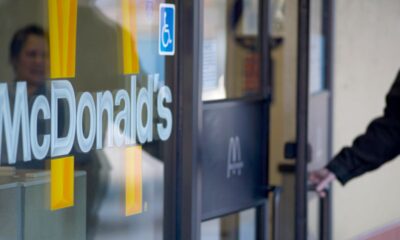Hawaii
Eight houses in Hawaii that celebrate island views

Large, overhanging roof eaves and homes with multiple dwellings are featured in this roundup of eight houses located on the islands of Hawaii.
Designed by studios such as Walker Warner Architects, Olson Kundig and more, many of the eight residences below feature roofs informed by vernacular architecture and a variety of semi-enclosed spaces to take advantage of Hawaii’s plentiful views.
Hawaii has more than 137 islands, with eight major islands holding most of the buildings.
While the whole cluster of islands is considered the US state of Hawaii, its largest island – referred to sometimes as The Big Island – is called Hawaii. Many of the houses on this list rest on that landmass.
From a house organised around a central courtyard to one enclosed in wooden storm shutters, they illustrate different techniques in adapting structures to the island state’s moderate tropical climate.
Read on for eight residences spread throughout Hawaii’s major islands.
Hale Kiawe, Hawaii, by Walker Warner Architects
This family house is located along the Kona Coast on The Big Island and encompasses a main dwelling, two guesthouses a detached garage and a swimming pool.
Its design was influenced by a traditional Hindu system of architecture called Vastu Shastra, following the client’s Indian heritage.
Find out more about Hale Kiawe ›

Hale Napo’o, Kauai, by Olson Kundig Architects
Located on the northern coast of the island of Kauai, Hale Napo’o is covered by a series of wooden storm shutters and deep overhangs.
Its expansive, hipped roof was informed by a style popularised by local architect CW “Pop” Dickey in the 1920s and 1930s.
Find out more about Hale Napo’o ›

Musubi, Hawaii, by Craig Steely Architecture
Named after a popular triangular Japanese snack – also referred to as onigiri, the Musubi house is organised around a central triangular courtyard and topped with an overhanging “diamond-shaped” roof.
Its main structure is also shaped like a triangular, albeit with curved corners, and contains two bedrooms, a kitchen and a large, sunken living room.
Find out more about Musubi ›

Villa, Hawaii, by De Reus Architects
De Reus Architects perched this residence on a swath of solidified lava, which overlooks the leeward side of The Big Island.
Totalling 10,000 square feet (929 square metres), the house was broken into individual volumes, including a series of bedrooms which extend off the main house.
Find out more about Villa ›

Hale Mau’u, Hawaii, by Walker Warner Architects
Hale Mau’u is located in the “arid plain” of The Big Island and is comprised of several, separate volumes.
“The arrangement of the 4,817-square-foot (447-square-metre) compound had to do three things: catch the mountain view, catch the ocean view, and then block the view of the neighbouring houses,” said the Walker Warner Architects co-founder Greg Warner.
Find out more about Hale Mau’u ›

Kua Bay Residence, Hawaii, by Walker Warner Architects
Kua Bay Residence is a basalt and cedar-clad house perched on a mountainside of lava rock, with rooms and spaces that flow into one another, influenced by its coastal setting.
Taking cues from how the lava formation and water flow towards the Pacific Ocean, the interior is meant to seamlessly transition between spaces.
Find out more about Kua Bay Residence ›

LifeEdited: Maui, Maui, by LifeEdited
Design consultancy LifeEdited built this Maui home as a model for sustainable, off-grid living.
Strategies such as solar-powered electricity, a rain water collection system, and efficient LED lighting were integrated throughout the house, which is designed to comply with the Hawaii Clean Energy Initiative, a program aimed at implementing 100 per cent clean energy across the archipelago.
Find out more about LifeEdited: Maui ›

Hale Lana, Hawaii, by Olson Kundig
Hale Lana is a 17,200-square-foot (1,598-square-metre) house comprised of five pavilions with overhanging roofs for a couple who wanted ample space for hosting.
Open spaces and the large roof planes usher breezes through the building, informed by techniques in local Hawaiian vernacular architecture.

Hawaii
Healthier Hawaii: How to protect your hearing; head and neck warning signs you shouldn’t ignore

HONOLULU (HawaiiNewsNow) – You may have received new earbuds or headphones during the holidays. But there are a few things you keep in mind when it comes to protecting your hearing.
Dr. Ross Shockley, an otolaryngologist with Wilcox Medical Center and Kaua‘i Medical Clinic, offers the following tips for hearing, as well as head and neck health.
Head and neck cancers
Many people are not familiar with head or neck cancers. What causes it and when should someone see a doctor?
- Traditionally, head and neck cancers were mostly associated with longtime smokers and drinkers. Now, more cases are tied to human papillomavirus (HPV), even in nonsmokers and drinkers. HPV is the same virus that can lead to cervical cancer in women. It is common and can have no symptoms.
- If you have throat pain, pain when swallowing that doesn’t go away, or a mass in your neck that feels firm and isn’t moving, don’t wait. See your doctor.
- Head and neck cancers can be treated, no matter the cause, if caught early.
How to prevent hearing loss
More young adults, in their early 20s, are experiencing hearing loss. Can hearing loss be reversed?
- Hearing loss can’t be reversed. Once ringing in ears starts, that can be permanent.
- Wear appropriate hearing protection when using power tools or firing weapons.
- You can find ear protection that blocks out sound for about $15. Protection that covers the whole ear are better than earplugs.
How do you know if music or movies are too loud?
- Don’t turn anything up to the maximum.
- You want the volume to be at the lowest level where you can still hear and understand.
- If there is background noise, don’t crank up the volume all the way to fight it. Use noise-cancelling headphones or go somewhere quieter.
Dangers of cleaning your ears
You may feel the urge to clean your ears. Shockley says do less, or even nothing at all.
- Our ears clean themselves. As new skin grows, it takes wax with it out of your ear.
- When you clean your ears, you’re interrupting that natural cleaning process.
- You can also put yourself at risk for external ear infections – or make your ears itch more.
Copyright 2026 Hawaii News Now. All rights reserved.
Hawaii
Hawaii Grown: Few isle players in College Football Playoff final four | Honolulu Star-Advertiser
Hawaii
Hawaii Island asks for the public’s assistance finding elderly woman, Jacquelyn Glenn

HONOLULU (HawaiiNewsNow) – Hawaii Island police are renewing their request for the public’s assistance in locating 82-year-old Jacquelyn Glenn of Kailua-Kona, who was reported missing by her family.
Police said she is considered endangered due to her age.
Glenn was last seen on Friday, Dec. 5, around 6:37 a.m., on the 75-200 block of Nani Kailua Dr. in Kailua-Kona.
She was wearing a peach-colored shirt, blue denim jeans, and black tennis shoes. She reportedly mentioned going to Hilo with friends, but did not say when she planned to return.
She is described as 5′6″, 125 Ibs, with curly grey hair and brown eyes.
Police ask anyone with information on the whereabouts of Jacquelyn Glenn to call the Hawaii Police Department’s non-emergency line at (808) 935-3311.
Copyright 2026 Hawaii News Now. All rights reserved.
-

 News1 week ago
News1 week agoFor those who help the poor, 2025 goes down as a year of chaos
-

 Detroit, MI4 days ago
Detroit, MI4 days ago2 hospitalized after shooting on Lodge Freeway in Detroit
-
Georgia1 week ago
Best in Georgia: 2025 AJC Varsity high school football all-state teams
-

 Dallas, TX3 days ago
Dallas, TX3 days agoDefensive coordinator candidates who could improve Cowboys’ brutal secondary in 2026
-

 Detroit, MI1 week ago
Detroit, MI1 week agoWith 46k outages around Michigan, Metro Detroit prepares for power loss
-

 Southeast1 week ago
Southeast1 week agoMurder in small-town America: The crimes that tore quiet communities apart in 2025
-

 Miami, FL1 week ago
Miami, FL1 week agoMiami-Dade sheriff’s deputy opens fire on vehicle after altercation during traffic stop, officials say
-

 Midwest1 week ago
Midwest1 week agoMcDonald’s locks doors to keep out individuals who present ‘a risk’ in crime-ridden Minneapolis area
























